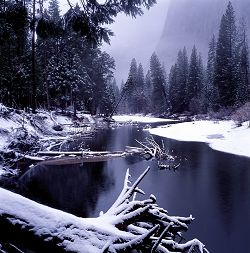Click here for www.PriceLine.com

|
When people think of visiting Yosemite, they generally think the best time
would be in the summer.
This is not always true. Yosemite's frosty winter mornings are just as
beautiful as a warm summer morning. In winter, Yosemite turns into an
ethereal and tranquil National Park. For the best experience one needs to become part of Yosemite. Two ways to do this are photography walks and guided snowshoe excursions.
PHOTOGRAPHY WALKS
GUIDED SNOWSHOE EXCURSIONS
ABOUT YOSEMITE Later, John Muir's struggle against the devastation of the subalpine meadows surrounding Yosemite Valley resulted in the creation of Yosemite National Park on October 1, 1890. Military units with headquarters in Wawona administered the park while the State of California continued to govern the area covered by the original 1864 grant. Dual control of Yosemite came to an end in 1906, when the State of California receded Yosemite Valley and the Mariposa Grove to the federal government. Civilian park rangers took over from the military in 1914. Two years later, on August 25, 1916, through the persistent efforts of Steven Mather and Horace Albright, Congress authorized the creation of the National Park Service to administer all national parks "in such manner and by such means as to leave them unimpaired for the enjoyment of future generations." Around the turn of the century, Hetch Hetchy Valley became the center of a bitter political struggle when the City of San Francisco wanted to dam the Tuolumne River inside Yosemite National Park as a source of drinking water and hydroelectric power. In 1913, conservationists led by John Muir lost the battle when Congress passed the Raker Act, authorizing the construction of O'Shaughnessy Dam. Impacts resulting from increasing visitation in Yosemite Valley became apparent. People camped throughout meadows and dramatically increasing automobile traffic driving on unpaved roads left the Valley dull with dust each summer. As visitation and need for year-round services increased, Yosemite Village was relocated from a location in the floodplain on the south side of the Merced River to the present Yosemite Village site to the north. Visitation exceeded one million in 1954 for the first time, and by 1976 over two million people visited Yosemite. In the mid-1990s, visitation topped four million. In the early 1970s, the National Park Service established one-way road traffic patterns, eliminated cars in the far east end of the Valley, offered free shuttle bus transportation in the Valley, converted the parking lot in front of the Valley Visitor Center to a pedestrian mall, and generally encouraged visitors to enjoy the park by walking or using public transportation.
|